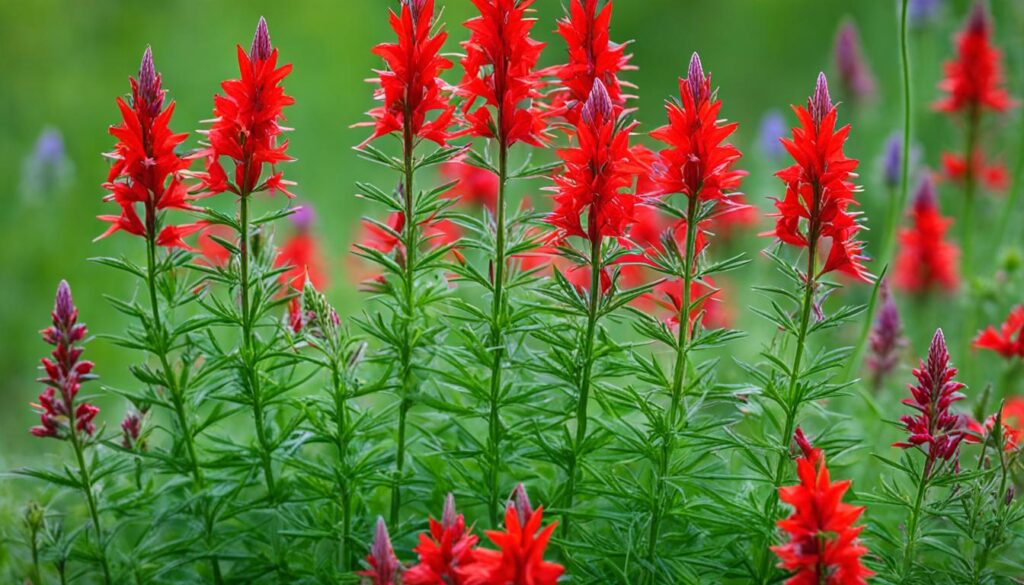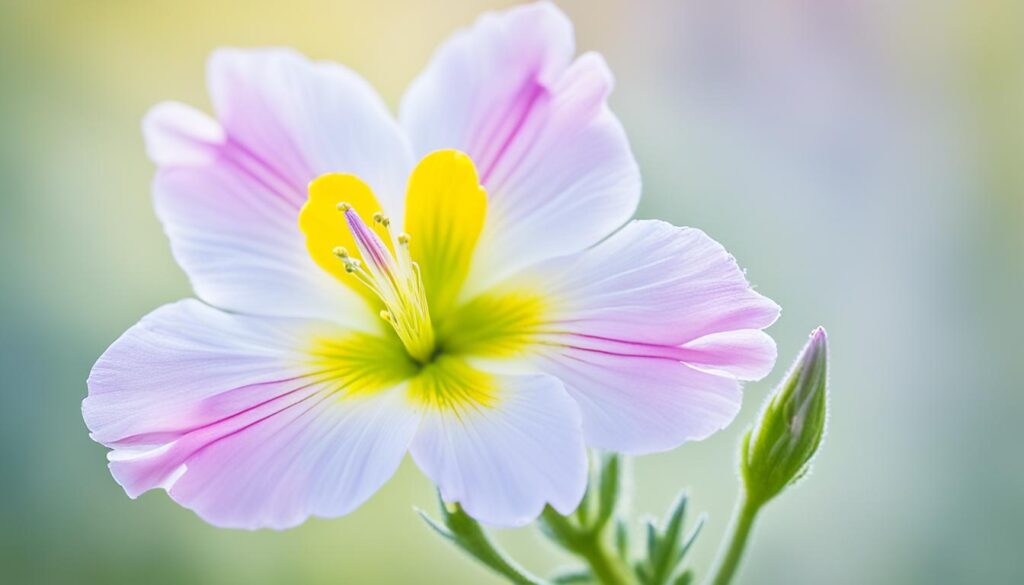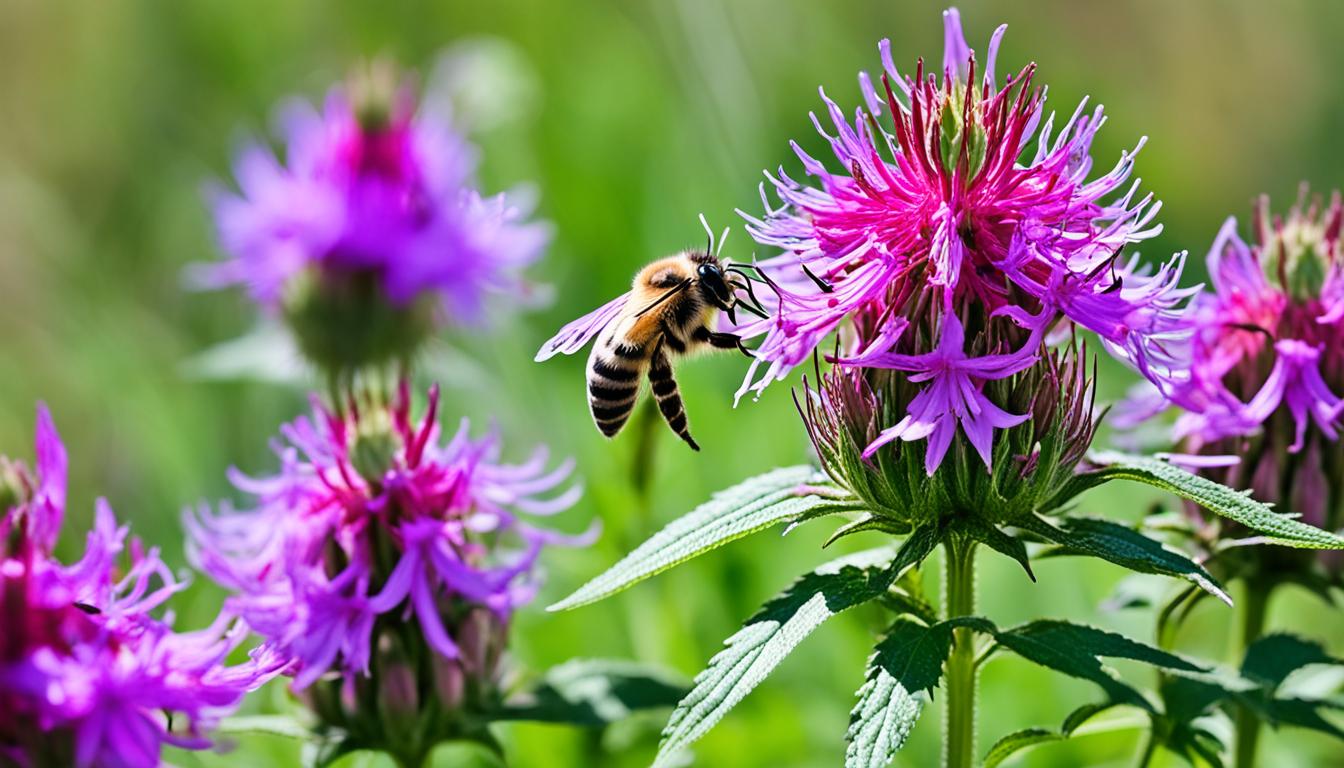Native plants and wildflowers not only look beautiful but also help local ecosystems. They are essential for attracting interesting wildlife. Whether you’re an expert or just starting, wildflowers can add color to your garden.
There are many wildflower species, but it’s important to know which are great for home gardens. This list includes wildflowers perfect for all types of landscapes. You’ll find 17 essential wildflowers here, from perennials to biennials.
Bee Balm
Bee Balm shines with bright scarlet flowers and can grow 2 to 4 feet tall. Its minty leaves add beauty too. Loved by hummingbirds, butterflies, and bees, it grows best in Zones 3 to 9 with sunlight. It’s ideal for rain or bog gardens due to its love of moist soil.
Black-eyed Susan
Black-eyed Susan is a familiar sight in the U.S., bringing joy with its yellow petals. It stands at 1 to 3 feet tall. This flower spreads easily, making it great for large areas. It also draws birds that eat its seeds. It thrives in Zones 3 to 10.
Cardinal Flower
The Cardinal Flower dazzles with its tall, red blooms that stand out at 3 to 4 feet high. It does well in the shade but can handle some sun if it’s cool. This flower attracts hummingbirds and likes wet areas. It’s perfect for bogs or rain gardens and grows best in Zones 3 to 9.
Common Evening Primrose
The Common Evening Primrose is a biennial with yellow flowers that bloom in the evening. It can grow up to 3 to 5 feet and does well in sun or shade. This flower is great for rocks or wildflower meadows. It’s suited for Zones 4 to 8.
Milkweed
Milkweed is crucial for monarch butterflies, growing up to 5 feet and blooming pink to purple. Its seeds are unique, dispersing on the wind. By planting milkweed, you help butterflies and support their populations. It’s made for Zones 3 to 9.
Key Takeaways:
- Native plants and wildflowers enhance garden beauty and support local ecosystems.
- Choose wildflowers that are native or established without crowding out true natives.
- The 17 wildflowers listed are popular and suitable for home gardens.
- Consider the height, plant hardiness zones, and specific growing conditions when selecting wildflowers.
- Wildflowers attract pollinators, add biodiversity, and create stunning floral arrangements.
Bee Balm
Bee Balm, or Monarda, is a stunning wildflower native to North America. It brightens up any garden with its red blooms. It grows up to 6 feet tall, attracting birds, butterflies, and bees.
It’s more than just a pretty plant. Bee Balm helps your garden look good and helps the environment. It feeds hummingbirds, butterflies, and bees, making the local area healthier.
This plant is from places like CT and NY in the US, and some parts of Canada. It does well by water like in meadows or near streams, up to 6500 feet high. Bee Balm can grow in the shade or under the sun, fitting various garden types.
It’s a great choice for rain gardens or bogs. Bee Balm loves wet areas. It will brighten up these spots with its red flowers.
Besides its uses in nature, Bee Balm plays a role in tea and medicine. It helps make Earl Grey tea taste special. People have used it for health issues like worms, gas, and fevers for a long time.
You can easily add Bee Balm to your garden in a few ways. It grows from seeds, cuttings, or by dividing its roots. To keep it healthy, divide the plant every three years.
Overall, Bee Balm is a great choice for any garden. Its red flowers attract beautiful creatures. It looks lovely and has many benefits for your garden.

Black-eyed Susan
Black-eyed Susan, or Rudbeckia hirta, is a popular wildflower in the U.S. It can live for a year, two years, or a few seasons. This makes it loved by those who plants gardens.
The flower’s yellow petals with dark centers are large, at 2-3 inches. They bring a bright look to gardens or fields. Its stems stand up to 3 feet high, making it a striking view.
These flowers are seen from March to November and come in red, orange, and yellow. So, they draw in pollinators like bees and butterflies. Many birds and specific butterflies raise their young near these flowers.
Black-eyed Susan grows in various states across the U.S. Places like AL, FL, TX, CA, and more are home to this flower. It fits well in sunny spots like fields, roadsides, and lake banks.
This plant is easy to care for and good at spreading on its own. You can plant its seeds in fall or spring. It’ll keep spreading, filling up areas with color.
This flower is not just pretty; it’s also helpful. It doesn’t attract deer and doesn’t need a lot of water. But occasional watering helps it do even better.
You can see Black-eyed Susan in many gardens and parks around the U.S. These spots include the Lady Bird Johnson Wildflower Center.
Varieties of Black-eyed Susan
- Var. hirta: Recognized as the most common variety, it features coarsely toothed, egg-shaped leaves and is found from Illinois eastward.
Gloriosa Daisy is a type of Black-eyed Susan that’s well-liked. It has a big, bright red center on each flower. This and other types bring new patterns to classic gardens.
The seeds of this flower don’t have soft hairs but last through winter. Birds find these seeds tasty. The plant’s leaves are long and narrow, with short, stiff hairs.
Overall, Black-eyed Susan is a standout in gardens, making them lively and supporting wildlife. It’s a top choice for people who want pretty, easy-care plants in their yards.
Cardinal Flower

The astonishing Cardinal Flower (Lobelia cardinalis) grows up to 3-4 feet tall. It features eye-catching red flowers in spiky 8-inch clusters. These flowers bloom from May through October and come in bright reds, reds with yellow lobes, or fully yellow.
This beautiful wildflower is native in many U.S. states. From Alabama to California, it flourishes in various conditions. You can find it from Canada’s New Brunswick to Mexico. It grows near water, in woodlands, along streams, and on roadsides, liking both sun and shade.
This flower is a favorite for wildlife, especially hummingbirds. It also resists deer, which is great news for gardeners. Its flowers support natural areas and local animal life.
You can grow this plant from seeds. They should be cold and wet in a fridge for three months. But, growing it could be tricky because it’s picky about its living conditions.
Regarding conservation, the Cardinal Flower indicates the health of wetland areas. Protecting it is critical due to over-collection and changes in its environment. In Florida, it’s at serious risk, but in New York, it’s a protected treasure. There, within the Adirondack Park, it blooms in vivid colors from late July to September.
This flower’s preference for wet areas is why it’s good for swamp and rain gardens. It loves moist soils and helps diversify wetland ecosystems. If you’re looking to boost biodiversity in your garden, consider planting this beautiful flower.
Common Evening Primrose

The common evening primrose is a biennial wildflower. It blooms from early summer to early autumn. Its flowers open suddenly at dusk and close in the morning, attracting night-flying moths with their scent.
This beautiful wildflower can grow up to about 6 feet tall. It adds height and elegance to your garden.
Common evening primrose is native to dry, rocky plains and other places. It is very common, found across various states in the USA and Canada.
The native distribution of common evening primrose stretches far and wide. It attracts birds, hummingbirds, and native bees to pollinator gardens.
Common evening primrose thrives in full sun or partial shade. It is great for rock gardens and wildflower meadows. The bloom time is from July to October, adding color and charm to your spaces.
Its yellow flowers are eye-catching. They have 4 heart-shaped petals and 8 stamens. Common evening primrose is sure to make a statement in any garden.
The leaves of common evening primrose are basal and alternate. They range from 4 to 12 inches long and ¾ to 2 inches wide.
Propagation and Maintenance
It can be grown from seeds or tip cuttings. In gardens, it can spread. But you can control this by removing extra seedlings.
Whether in a garden or meadow, this wildflower brings beauty. It’s loved by gardeners and wildlife enthusiasts for its blooms and visitors it attracts.
Milkweed
Milkweed is a key wildflower that helps protect monarch butterflies. It is known as Asclepias syriaca L. and grows up to 8 feet tall.
Its leaves vary in shape and size, ranging from ovate to elliptic. Each stem produces 3 umbels with about 30 flowers in each.
The plant’s natural range covers a wide area in North America. Here, it grows in fields, along roads, and in other sunny, moist spots. It’s found from Canada’s plains to the southern U.S. and as far west as Iowa.
Milkweed is critical for the life of monarch butterflies. It also supports the well-being of various bee species. The plant’s sap is toxic to some insects and animals in large doses.
By planting milkweed, you can help conserve monarchs. This flower is best suited for zones 3 to 9 and offers beautiful blooms. Its seeds spread in a unique way, carried by the wind on fluffy fibers.
